Awards
Simberloff Award for Outstanding Presentation
The Invasion Ecology Section, along with Biological Invasions and Springer International Publishers, is pleased to sponsor the annual Simberloff Award for Outstanding Presentation. The award’s name is in recognition of the contributions of the Editor-in-Chief of Biological Invasions, Daniel Simberloff, to the study of nonnative species. The award will be given to two student presenters at ESA’s annual meeting who embody Simberloff’s creativity, intelligence, and passion for studying and understanding the biology of nonnative organisms. Entrants are judged on the rigor, creativity, importance, and quality of their research and its presentation. Each winner will receive a $250 cash award and will have their achievements published in Biological Invasions.
Eligibility Requirements for Student Presenters
1. The student entrant must be first author and presenter for the paper or poster.
2. Student is defined as an undergraduate or graduate student who is currently enrolled in a degree program or who finished their degree within the last 12 months*.
3. The student must be an Invasion Ecology section member at the time of the presentation. Not a member of the invasion Ecology section? No problem and it’s easy to join. Just go to the ESA membership site for more information.
4. Past winners are prohibited from re-entering the competition
*The research presented must be the students own work that was conducted before their graduation date.
How to enter:
FIRST: Complete the following registration form declaring your intent to enter the competition. If you are interested in judging, you can also use this form to apply
SECOND: Upload your oral presentation or poster to the following google drive
To apply please submit the entry form by Friday 28st July, 11:59 PM EST and upload your presentations to the google drive by Friday August 11, 11:59 PM EST. We ask that all judges view presentations and submit their scores (instructions forthcoming) by Monday August 21st, 11:59 PM EST. Judges will be contacted before the conference with a list of students presentations or posters to evaluate.
If you have any questions or have problems registering or uploading your presentations/posters, please contact either Andrew Davinack (davinack_drew@nullwheatoncollege.edu ) or Rebecca Lemons (rebecca.lemons@nulloregonstate.edu)
To learn more about this award and its namesake, see the following publication in Biological Invasions:
Kuebbing, S.E., and L.A. Meyerson. Honoring Daniel Simberloff: An unwavering champion of invasion biology. Biological Invasions 20:3379–3383. https://doi.org/10.1007/s10530-018-1878-x
Congratulations to Kay Strain and Taylor Zallek! Our 2022 Simberloff Award Winners!🎉
Kay Strain, University of Nevada-Reno
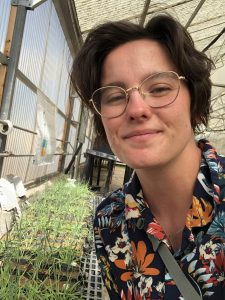
Poster presentation
Cheatgrass (Bromus tectorum) modifies the soil microbial community
Kay is a fourth-year Ph.D. student in Fire and Dryland Ecosystems lab in the University of Nevada, Reno. Their research investigates how drought interacts with grass invasion and wildfire to influence nutrient cycling and retention in drylands. In their winning poster, Kay found an interesting belowground feedback mechanism in invasive cheatgrass, in which root exudation increases nitrogen (N) availability by suppressing heterotrophic microbes (See poster below).
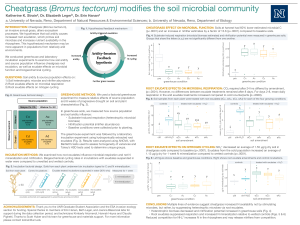
Taylor Zallek University of Pittsburgh
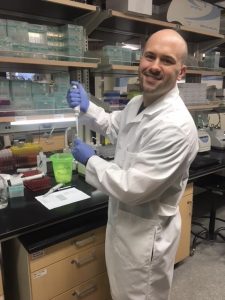 oral presentation
oral presentationTaylor’s favorite Simberloff paper is Simberloff & Von Holle 1999.” This paper and the concept of invasional meltdowns provided the framework for my very first experience conducting research as an undergraduate student at St. John’s University in central Minnesota. We measured the potential synergistic effects of invasive understory shrubs and earthworms in deciduous forests. This paper, and the experience that accompanied it, made me curious about the multitude of factors that influence invasions and sent me on a journey that I continue to pursue to this day!”
Simberloff Award winners 2021:
Congratulations Angela Walczyk and William Pfadenhauer!
Angela Walczyk, Michigan Technological University
Oral presentation
Investigating phenotypic plasticity in biological invasions and implications for the invasive success of tetraploid Solidago gigantea (Giant Goldenrod, Asteraceae)
Angela is a Ph.D. candidate interested in how polyploidy influences plant responses to the biotic and abiotic environment. In her talk, she presented research testing the hypothesis of higher phenotypic plasticity in successful invasive species, using goldenrod (Solidago gigantea, Asteraceae) as a model. In a thorough experiment, morphological and physiological traits of native and invasive goldenrod were contrasted, finding that native goldenrod has more phenotypic plasticity in biomass accumulation and height than invasive goldenrod. Other traits didn’t show phenotypic plasticity differences between treatments. Additional studies were required for defensive traits. Research like this is very relevant as it is one of the few studies controlling for the potential effects that polyploidy might have on PP by comparing only native and invasive populations of the same ploidy level. Well done Angela!
What Simberloff publication is most inspiring to you and why?
Genovesi, P. and Simberloff D. (2020). “De-extinction” in conservation: Assessing risks of releasing“ resurrected” species. Journal for Nature Conservation. 56:125838. I was introduced to the topic of “de-extinction” in a Conservation Biology class, and since then I have found its proposal as an innovative conservation tool to be both fascinating and concerning. In this paper, Genovesi and Simberloff clearly discuss the risks and potential benefits of introducing extinct species proxies into modern ecosystems through the lens of invasive biology. I personally like this publication because its incorporation of conservation biology, policy making, and public opinion makes for a fantastic springboard into complex ecological discussions. For that reason, I feel that this publication is a strong learning tool that can enhance classroom discussions and students’ understanding of ecology and biology.
William Pfadenhauer, University of Massachussetts
Oral presentation
Identifying the biogeographic traits of invasive plants’ native habitats
Will is a PhD. Candidate at the Spatial Ecology Lab, UMass Amherst. He is interested in analyzing big data with spatial and statistical techniques to study global trends in plant invasions. For ESA 2021 he presented brilliantly how biogeographic data could be incorporated to risk assessments of invasive plants. To achieve this, a large dataset of biogeographic traits (characteristics of native plant habitat) was compiled for 5500 vascular plants native to the continental United States and each species are given an invasion status. Authors hypothesized that species with broader abiotic niches in the native habitat and species more accessible to human discovery (e.g., proximal to human footprint) would be more likely to establish and invade outside of the U.S. This seems to be the case for the US continental flora, as species that can tolerate a wider range of temperature, precipitation, soil pH, and soil texture were correctly predicted as invasive elsewhere. Thus niche breadth can be a valuable trait to incorporate into risk assessments and the variables described above can be easily obtained from current species occurrences repositories such as GBIF.
What Simberloff publication is most inspiring to you and why?
This is a tough choice, but I’d have to say “Ecological Resistance To Biological Invasion Overwhelmed By Propagule Pressure” by Von Holle and Simberloff (2005). I’m currently working on a project that evaluates the different pathways used by invasive plants to relocate to new environments, so these days I’m thinking a lot about propagule pressure, how it interacts with other variables, and the role it plays in the different phases of the invasion process. This publication clearly conveys the importance of propagule pressure in determining invisibility, and in doing so inspires me to better understand these underlying processes and help create more effective invasive plant management strategies in the future.
Congratulations to our 2020 winners Rebecca Mostow and Eve Beaury!
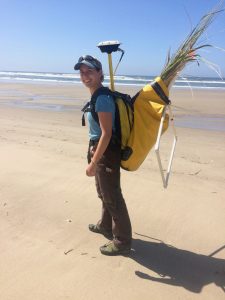
Rebecca Mostow, Oregon State University
Oral, Evolution: Genetic Isolation And Differentiation
Discovery of a novel, dune-building grass: Hybridization of non-native beachgrasses (Ammophila arenaria × breviligulata) along the U.S. Pacific Northwest coast
What is your year of study at your university? What lab do you belong to?
I am a 5th year PhD candidate working with Dr. Sally Hacker at Oregon State University.
What is your over-arching research topic?
I study the ecology and population genetics of two invasive, closely-related, dune-building beachgrasses. These two grasses densely invaded the US Pacific Coast leading to habitat loss for native flora and fauna but also dramatically increasing the coastal protection provided by dunes to nearby towns and cities. The discovery of a novel hybrid between the two species (as described in my ESA talk) has pushed me to complete a truly interdisciplinary PhD, integrating genomic tools with models and theory from invasion ecology.
What Simberloff publication is most inspiring to you and why?
Rhymer, J. M., and D. Simberloff. 1996. Extinction by Hybridization and Introgression. Annual Review of Ecology and Systematics 27:83–109. https://doi.org/10.1146/annurev.ecolsys.27.1.83
Although it is hard to pick just one Simberloff paper, I think I have to go with Rhymer and Simberloff (1996). I became fascinated with invasive plants during a year working on plant conservation in the Great Basin. Every day I saw the immense ecological consequences of biological invasions and decided to go to grad school to study evolution in invasive plants, hoping to understand how these organisms were able to thrive in environments in which they did not originally evolve. This paper opened my eyes to the potential impact of hybridization, introgression, and gene flow between the species in my study system and helped me to understand the potential implications of our recent discovery. Additionally, as someone interested in science communication, I have always admired the clear, thorough, and well-reasoned style with which Dr. Simberloff always writes, this being no exception.
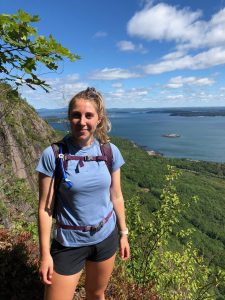
Evelyn “Eve” Beaury, University of Massachusetts Amherst
Oral, Invasion: Prevention And Management 1
Invaders for sale: The ongoing spread of invasive species by the plant trade industry
What is your year of study at your university? What lab do you belong to?
I am beginning my fourth year of my PhD in Organismic and Evolutionary Biology at the University of Massachusetts Amherst. I am part of Dr. Bethany Bradley’s spatial ecology lab.
What is your over-arching research topic?
I study the macroecology and biogeography of invasive plant presence, abundance, and impact. I’m particularly interested in research that intersects invasive species’ ecology, policy, and management, as well as interactions between invasive species and global change.
What Simberloff publication is most inspiring to you and why?
Simberloff, D., I.M. Parker, and P.N. Windle. 2005. Introduced species policy, management, and future research needs. Frontiers in Ecology and the Environment, 3(1):12-20. https://doi.org/10.1890/1540-9295(2005)003[0012:ISPMAF]2.0.CO;2
It is hard to choose just one, but I’m currently most inspired by Simberloff et al. (2005). This study reviews major issues in invasive species research, policy, and management, as well as advocates for why these three domains need to be better integrated. I am inspired by this review because I am most passionate about projects that connect science to real-world problems. Although published 15 years ago, Simberloff et al. 2005 highlights a disconnect between research and implementation that is still prevalent today and which is exemplified by the work on ornamental invasive plants that I presented at ESA. This publication, and many others by Simberloff, motivates me to work on projects that impact the way we study and manage invasions in the United States.
To learn more about the 2020 winners, see Biological Invasions.
Past Winners
2019
Emily Kiehnau, University of Oklahoma
Oral, Invasion: Species Interactions
Morphological changes of native Daphnia species in response to the invasive predator Bythotrephes longimanus
Patrick Milligan, University of Florida
Oral, Invasion: Ecosystem Processes
Short-term gains and long-term losses for an East African myrmecophyte, triggered by a biological invasion
To learn more about the 2019 winners, see the following publication in Biological Invasions:
Smith-Ramesh, L.M., and S. Kuebbing. 2020. Announcing the winners of the second annual Simberloff Award for outstanding presentation. Biological Invasions 22:851–852. https://doi.org/10.1007/s10530-019-02175-7
2018 | Inaugural
Amanda Carr, Western Washington University
Oral, Invasion: Invasibility, Stability, And Diversity
Propagule pressure, not diversity or disturbance, drove long-term invader success in a serpentine grassland
Carmela Buono, SUNY Binghamton
Poster, Invasion: Prevention And Management
Are ecological systems resilient to invasions? A systematic review of ecological response post-invasive species Management
To learn more about the 2018 winners, see the following publication in Biological Invasions:
Kuebbing, S.E., and L.A. Meyerson. 2018. Announcing the inaugural winners of the Simberloff Award for Outstanding Presentation. Biological Invasions 20:3377-3378. https://doi.org/10.1007/s10530-018-1877-y
2017 | Prior to Award Dedication
Chris Bowman-Prideaux, University of Idaho
Oral, Ecosystem Management I
Working together: Fire and post-fire rehabilitation create homogeneous plant communities
Rafael Valentin, Rutgers University
Oral, Genetics And Molecular Techniques
Utility of eDNA as a surveillance framework in terrestrial systems

